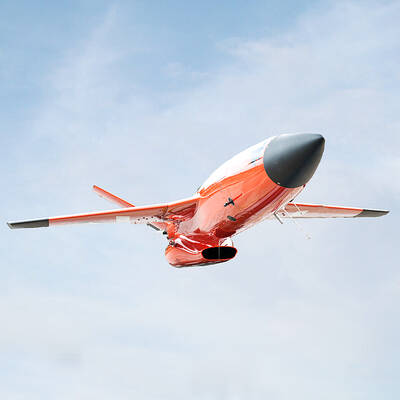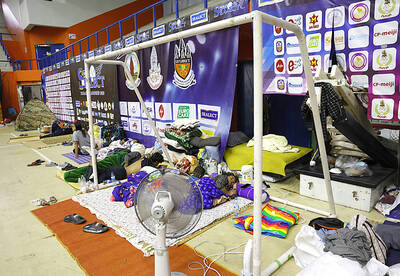A US aircraft carrier yesterday docked in Hong Kong, days after a pair of strategic bombers flew over the disputed South China Sea.
The arrival of the USS Ronald Reagan and its battle group in the Asian financial hub came after China rejected a similar request by another US Navy ship amid a spike in tensions between the countries’ militaries.
The Reagan’s visit is being seen as a friendly gesture ahead of a planned meeting later this month between US President Donald Trump and Chinese President Xi Jinping (習近平) that would mark the first time they have sat down together since the start of a bitter trade dispute.

Photo: Bloomberg
China has demanded that the US cease military activity of any kind near its island claims in the South China Sea that it has been rapidly fortifying.
The US has said it takes no stance on sovereignty claims, but would continue to sail and operate wherever international law permits.
The US Navy said in a statement that during the Reagan’s visit, interactions would take place with Hong Kongers through sports, community relations projects and tours of the carrier. More than 4,400 men and women are usually aboard the ship.
“The abundant growth and prosperity that surrounds us in Hong Kong is what the United States Seventh Fleet seeks to preserve for all nations in this important region,” Rear Admiral Karl Thomas, commander of Carrier Strike Group 5, said in the statement.
In comments to Hong Kong media on Tuesday, Thomas said the US and Chinese militaries are able to maintain a professional relationship, despite tensions.
“When we’re out at sea, we have a mission to do, and we come out and operate around each other, and we do it professionally,” Thomas said.
Meanwhile, US Pacific Air Forces said two B-52s flew over the South China Sea on Monday, calling it a “routine training mission.”
The bombers departed Andersen Air Force Base on Guam as part of the US Indo-Pacific Command’s continuous bomber presence operations that began in 2004, Pacific Air Forces said in a statement yesterday.
“This recent mission is consistent with international law and the United States’ long-standing commitment to a free and open Indo-Pacific,” the statement said.
Also this week, China has installed a new platform in the South China Sea on a remote part of the Paracel Islands (Xisha Islands, 西沙群島) that could be used for military purposes, according to recent satellite images reviewed by a US think tank.
The Asia Maritime Transparency Initiative of the Washington-based Center for Strategic and International Studies said that the images showed a “modest new structure” on Bombay Reef (浪花礁), topped by a radome and solar panels.
“The development is interesting given Bombay Reef’s strategic location, and the possibility that the structure’s rapid deployment could be repeated in other parts of the South China Sea,” the group said in a statement on Tuesday.
The purpose of the structures was unclear, but it could be for military use, it said.
“The reef is directly adjacent to the major shipping lanes that run between the Paracels and the Spratly Islands [Nansha Islands, 南沙群島] to the south, making it an attractive location for a sensor array to extend Chinese radar or signals intelligence collection over that important sea lane,” the group said.
The Chinese Ministry of National Defense did not respond to a request for comment.
Chinese Ministry of Foreign Affairs spokesman Geng Shuang (耿爽) said China’s sovereignty over the Paracel Islands was not in dispute, and there is nothing wrong with China carrying out construction work on its own territory.
“As for the specific situation you mention, I have no understanding of it,” Geng told a daily news briefing.
Taiwan and Vietnam also claim the Paracels.
The Vietnamese Ministry of Foreign Affairs did not immediately respond to a request for comment.
Additional reporting by Reuters

‘WIN-WIN’: The Philippines, and central and eastern European countries are important potential drone cooperation partners, Minister of Foreign Affairs Lin Chia-lung said Minister of Foreign Affairs Lin Chia-lung (林佳龍) in an interview published yesterday confirmed that there are joint ventures between Taiwan and Poland in the drone industry. Lin made the remark in an exclusive interview with the Chinese-language Liberty Times (the Taipei Times’ sister paper). The government-backed Taiwan Excellence Drone International Business Opportunities Alliance and the Polish Chamber of Unmanned Systems on Wednesday last week signed a memorandum of understanding in Poland to develop a “non-China” supply chain for drones and work together on key technologies. Asked if Taiwan prioritized Poland among central and eastern European countries in drone collaboration, Lin

The Chien Feng IV (勁蜂, Mighty Hornet) loitering munition is on track to enter flight tests next month in connection with potential adoption by Taiwanese and US armed forces, a government source said yesterday. The kamikaze drone, which boasts a range of 1,000km, debuted at the Taipei Aerospace and Defense Technology Exhibition in September, the official said on condition of anonymity. The Chungshan Institute of Science and Technology and US-based Kratos Defense jointly developed the platform by leveraging the engine and airframe of the latter’s MQM-178 Firejet target drone, they said. The uncrewed aerial vehicle is designed to utilize an artificial intelligence computer

Renewed border fighting between Thailand and Cambodia showed no signs of abating yesterday, leaving hundreds of thousands of displaced people in both countries living in strained conditions as more flooded into temporary shelters. Reporters on the Thai side of the border heard sounds of outgoing, indirect fire yesterday. About 400,000 people have been evacuated from affected areas in Thailand and about 700 schools closed while fighting was ongoing in four border provinces, said Thai Rear Admiral Surasant Kongsiri, a spokesman for the military. Cambodia evacuated more than 127,000 villagers and closed hundreds of schools, the Thai Ministry of Defense said. Thailand’s military announced that

CABINET APPROVAL: People seeking assisted reproduction must be assessed to determine whether they would be adequate parents, the planned changes say Proposed amendments to the Assisted Reproduction Act (人工生殖法) advanced yesterday by the Executive Yuan would grant married lesbian couples and single women access to legal assisted reproductive services. The proposed revisions are “based on the fundamental principle of respecting women’s reproductive autonomy,” Cabinet spokesperson Michelle Lee (李慧芝) quoted Vice Premier Cheng Li-chiun (鄭麗君), who presided over a Cabinet meeting earlier yesterday, as saying at the briefing. The draft amendment would be submitted to the legislature for review. The Ministry of Health and Welfare, which proposed the amendments, said that experts on children’s rights, gender equality, law and medicine attended cross-disciplinary meetings, adding that